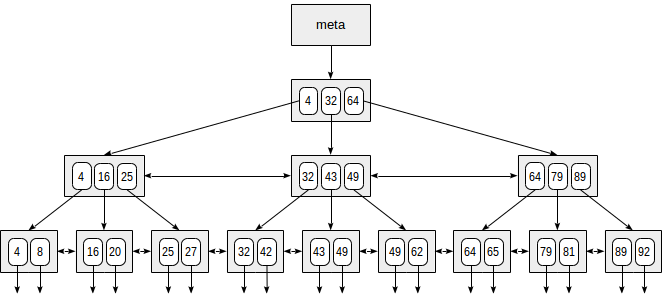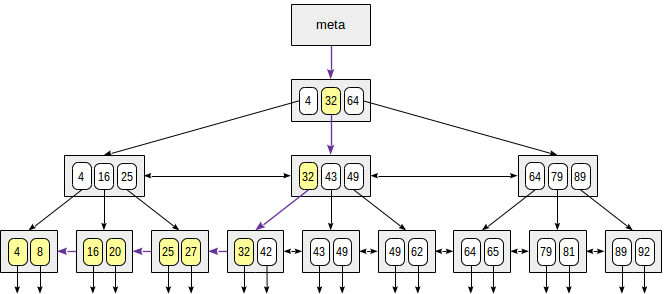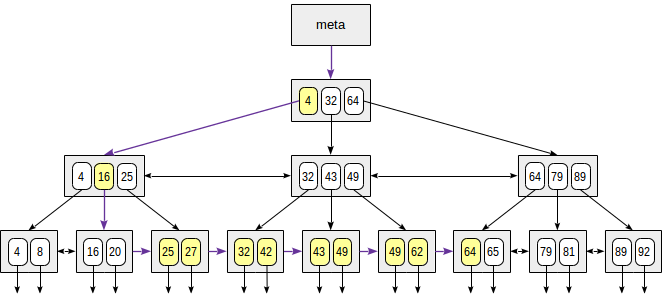本文翻译自 https://habr.com/en/company/postgrespro/blog/443284/,已经得作者同意。
我们已经讨论了 PostgreSQL 索引引擎和访问方法接口,以及其中一种访问方法:哈希索引。本文将介绍最传统且使用最广泛的索引:B-树。长文警告,请各位保持耐心。
B树
结构
B-树索引类型是 btree 访问方法的一种实现,适用于可排序的数据。也就是说,数据类型必须定义 greater , greator or equal , less , less or equal 和 equal 这些运算符。注意,相同的数据有时可能排序不同,这跟我们之前提到的运算符族的概念有关。
类似地,B-树的索引行也保存在对应的页中。叶子页(leaf page)中的索引行包含被索引的数据(key)和指向数据行的 TID;内部页(internal page)中,每行数据指向其一个孩子页,并且保存了该孩子页的最小值。
B-树有几个重要的特性:
- B-树是平衡树,这意味着每个叶子与根之间有相同数量的内部页。即,搜索任何值的时间是相同的。
- B-树是多路平衡树,即每个页(通常为 8KB)包含很多(数以百计)TID。因此,B-树的深度很小,对于非常大的表深度大概 4-5 层。
- 索引中的数据以非递减序(页面之间和页面内部都是)排列,同一层的页面通过双向链表彼此连接。因此,我们可以遍历链表或者反向遍历链表得到排序的数据,而无需每次都返回根页查找。
以下是一个简单的以整数为键的索引示例:
索引的第一个页是 mate 页,其指向索引的根节点。内部节点在根节点之下,叶子节点在最下层。最下边向下的箭头表示从叶子节点指向数据行(TID)。
等值搜索
我们来看看如何在树中通过一个形如 indexed-filed = expression 的等值条件搜索一个值。不妨假设我们想查询的键是 49。
搜索从根节点开始,随后需要确定向下到哪个子节点继续搜索。由于知晓根节点的值是 (4,32,64),我们可以计算出孩子节点中值的范围。由于 32 <= 49 < 64,我们需要到第二个孩子节点中搜索。接下来,重复递归相同的过程,直到到达叶子节点,从中获取到需要的 TID。
事实上,许多细节使这个看似简单的过程变得复杂。比如,索引键的值可能不是唯一的,且相同的值可能有很多,多到一个页都不足以容纳。还是回到上边的例子,也许在第二层查找时,我们应该定位到 49,但可以清楚地看到,这样将会跳过前一个叶子节点中的一个 49。因此,一旦在内部节点中找到一个与键值完全相等的值,我们必须向左挪动一个位置,然后从左到右查看其下层的索引行,以搜索所需的键。
(另一个复杂的问题是,在搜索期间,其他进程有可能会修复数据:树可能被重建,页面可能分裂等等。工程上所有算法都是为这些并发操作而设计的,确保这些操作不会相互干扰,也不会导致额外的锁开销。本文将尽量避免在这方面进行展开。)
非等值搜索
当使用形如 indexed-filed <= expression 的条件搜索时,首先通过等值条件 indexed-filed = expression 在索引中找到一个匹配的值(如果有的话),然后沿适当的方向遍历叶子节点直到结束。
下图描述了按条件 n <= 35 搜索的过程:
greater 和 less 运算符的搜索过程是类似的,但必须删除最初找到的相等的值。
范围搜索
当使用形如 expression1 <= indexed-field <= expression2 的范围条件搜索时,我们通过条件 indexed-field == expression1 找到一个值,然后遍历叶子节点,直到不再满足 indexed-field <= expression2 的条件;或者相反的顺序,从第二个表达式开始,然后沿相反的方向遍历叶子节点,直到不再满足第一个表达式。
举例
我们来看一个使用 B-树 的查询计划示例。照例使用我们的演示数据库,这次使用 aircrafts 表,仅包含 9 行数据。由于整张表仅有一页数据,计划器不会选择使用索引。但这个表在满足我们说明目的的同时还比较有趣,因此选择它。
demo=# select * from aircrafts;aircraft_code | model | range---------------+---------------------+-------773 | Boeing 777-300 | 11100763 | Boeing 767-300 | 7900SU9 | Sukhoi SuperJet-100 | 3000320 | Airbus A320-200 | 5700321 | Airbus A321-200 | 5600319 | Airbus A319-100 | 6700733 | Boeing 737-300 | 4200CN1 | Cessna 208 Caravan | 1200CR2 | Bombardier CRJ-200 | 2700(9 rows)demo=# create index on aircrafts(range);demo=# set enable_seqscan = off;
(或者显式地用 using btree(range) 在 aircrafts 表上创建索引,若不指定,默认创建的就是 B-树索引。)
等值搜索:
demo=# explain(costs off) select * from aircrafts where range = 3000;QUERY PLAN---------------------------------------------------Index Scan using aircrafts_range_idx on aircraftsIndex Cond: (range = 3000)(2 rows)
不等式搜索:
demo=# explain(costs off) select * from aircrafts where range < 3000;QUERY PLAN---------------------------------------------------Index Scan using aircrafts_range_idx on aircraftsIndex Cond: (range < 3000)(2 rows)
范围搜索:
demo=# explain(costs off) select * from aircraftswhere range between 3000 and 5000;QUERY PLAN-----------------------------------------------------Index Scan using aircrafts_range_idx on aircraftsIndex Cond: ((range >= 3000) AND (range <= 5000))(2 rows)
排序
再次强调,无论使用何种扫描方式(index,index-only 或 bitmap), btree 访问方法都返回有序的数据,从上文的图示中也可以清楚地看到这一点。
因此,如果一个表在排序条件上有索引,优化器将有两种选择:索引扫描,或顺序扫描并对结果排序。
排列顺序
创建索引时可以显式指定排列顺序,比如,我们可以按航班飞行距离创建索引:
demo=# create index on aircrafts(range desc);
此时,较大的值将在 B 树的左侧,而较小的值在右侧。既然我们可以从两个方向上遍历索引值,为什么还需要指定排列顺序呢?
其目的是多列索引。我们创建一个视图,将飞机划分为短程、中程和远程:
demo=# create view aircrafts_v asselect model,casewhen range < 4000 then 1when range < 10000 then 2else 3end as classfrom aircrafts;demo=# select * from aircrafts_v;model | class---------------------+-------Boeing 777-300 | 3Boeing 767-300 | 2Sukhoi SuperJet-100 | 1Airbus A320-200 | 2Airbus A321-200 | 2Airbus A319-100 | 2Boeing 737-300 | 2Cessna 208 Caravan | 1Bombardier CRJ-200 | 1(9 rows)
然后,创建一个表达式索引:
demo=# create index on aircrafts((case when range < 4000 then 1 when range < 10000 then 2 else 3 end),model);
现在,我们可以使用索引来获取按两列升序排列的数据。
demo=# select class, model from aircrafts_v order by class, model;class | model-------+---------------------1 | Bombardier CRJ-2001 | Cessna 208 Caravan1 | Sukhoi SuperJet-1002 | Airbus A319-1002 | Airbus A320-2002 | Airbus A321-2002 | Boeing 737-3002 | Boeing 767-3003 | Boeing 777-300(9 rows)demo=# explain(costs off)select class, model from aircrafts_v order by class, model;QUERY PLAN--------------------------------------------------------Index Scan using aircrafts_case_model_idx on aircrafts(1 row)
同样,也可以获取降序排列的数据:
demo=# select class, model from aircrafts_v order by class desc, model desc;class | model-------+---------------------3 | Boeing 777-3002 | Boeing 767-3002 | Boeing 737-3002 | Airbus A321-2002 | Airbus A320-2002 | Airbus A319-1001 | Sukhoi SuperJet-1001 | Cessna 208 Caravan1 | Bombardier CRJ-200(9 rows)demo=# explain(costs off)select class, model from aircrafts_v order by class desc, model desc;QUERY PLAN-----------------------------------------------------------------Index Scan BACKWARD using aircrafts_case_model_idx on aircrafts(1 row)
然而,我们无法使用该索引获取按一列降序、另一列升序的数据。这需要额外的排序操作:
demo=# explain(costs off)select class, model from aircrafts_v order by class ASC, model DESC;QUERY PLAN-------------------------------------------------SortSort Key: (CASE ... END), aircrafts.model DESC-> Seq Scan on aircrafts(3 rows)
(注意,计划器无视我们上文中设置的 enable_seqscan=off 仍然选择了顺序扫描。事实上,这种设置并不能禁止表扫描,而只是将扫描代价设置为较大的值。可以在执行 explian 时设置 cost on 来查看代价。)
为了使该查询可以使用索引,需要创建一个满足所需排序的索引:
demo=# create index aircrafts_case_asc_model_desc_idx on aircrafts((casewhen range < 4000 then 1when range < 10000 then 2else 3end) ASC,model DESC);demo=# explain(costs off)select class, model from aircrafts_v order by class ASC, model DESC;QUERY PLAN-----------------------------------------------------------------Index Scan using aircrafts_case_asc_model_desc_idx on aircrafts(1 row)
列的顺序
使用多列索引时的另一个问题是索引中列的顺序。对于 B-树 索引而言,顺序是非常重要的:页面内的数据首先按第一个字段排序,然而按第二个字段排序,以此类推。
我们可以用下图表示在 range 和 model 上创建的多列索引:

事实上,一个根节点足以容纳这样一个很小的索引。但为方便描述,上图特意将其分布在多个页中。
从上图可以清楚地看到,通过诸如 class = 3 (仅通过第一个字段 进行搜索)或 class = 3 and model = 'Boeing 777-300' (同时搜索两个字段) 这样的谓词搜索将会非常高效。
而根据谓词 model = 'Boeing 777-300' 进行搜索的效率则很低:从根节点开始,我们无法判断应该向下搜索哪个子节点,因此必须搜索每一个子节点。但这并不意味着这样的索引不能使用,只是效率堪忧。例如,如果我们有三类飞机,每一类又有很多型号,我们将不得不扫描整个索引的约 1/3,这可能比全表扫描更加高效,当然,也可能相反。
如果我们创建如下索引:
demo=# create index on aircrafts(model,(case when range < 4000 then 1 when range < 10000 then 2 else 3 end));
字段的排序将会发生改变:
创建该索引之后,通过谓词 model = 'Boeing 777-300' 搜索将非常高效,而通过谓词 class = 3 搜索的效率则不尽如人意。
NULL
btree 访问方法可以索引 NULL 值,并支持通过 IS NULL 和 IS NOT NULL 进行搜索。
让我们看看有 NULL 值得 flights 表:
demo=# create index on flights(actual_arrival);demo=# explain(costs off) select * from flights where actual_arrival is null;QUERY PLAN-------------------------------------------------------Bitmap Heap Scan on flightsRecheck Cond: (actual_arrival IS NULL)-> Bitmap Index Scan on flights_actual_arrival_idxIndex Cond: (actual_arrival IS NULL)(4 rows)
NULL 值位于叶子节点的一端或者另一端的末尾,具体取决于创建索引的方法(NULLS FIRST 或 NULLS LAST)。这对包含排序的查询是至关重要的:如果 SELECT 命令在其 ORDER BY 子句中指定的 NULL 值顺序与创建索引时指定的 NULL 值顺序相同(NULLS FIRST 或 NULLS LAST),则可以使用该索引。
以下例子中,查询要求的 NULL 值排序就与索引的 NULL 值排序相同,因此可以使用索引:
demo=# explain(costs off)select * from flights order by actual_arrival NULLS LAST;QUERY PLAN--------------------------------------------------------Index Scan using flights_actual_arrival_idx on flights(1 row)
以下查询要求的 NULL 值排序则与索引不同,因此,优化器选择顺序扫描并进行排序:
demo=# explain(costs off)select * from flights order by actual_arrival NULLS FIRST;QUERY PLAN----------------------------------------SortSort Key: actual_arrival NULLS FIRST-> Seq Scan on flights(3 rows)
该查询若想使用索引,需要创建一个 NULL 值排在前面的索引:
demo=# create index flights_nulls_first_idx on flights(actual_arrival NULLS FIRST);demo=# explain(costs off)select * from flights order by actual_arrival NULLS FIRST;QUERY PLAN-----------------------------------------------------Index Scan using flights_nulls_first_idx on flights(1 row)
NULL 值只能存储在所有叶子节点最开始或最末尾这个问题的根本原因是 NULL 值不能进行排序,即 NULL 与其他任何值比较的结果都是未定义的。
demo=# \pset null NULLdemo=# select null < 42;?column?----------NULL(1 row)
这与 B-树 的概念背道而驰,也区别于一般的模式。而 NULL 在数据库系统中扮演着非常重要的角色,因此我们不得不为它做一些特殊处理。
由于 NULL 可以被索引,使得即便没有在表上施加任何条件也可以使用索引成为可能(因为索引肯定包含表中所有行的信息,包括是 NULL 的行)。如果查询需要排序,并且索引可以确保所需的顺序,那么这可能是有意义的。在这种情况下,计划器可以选择索引访问避免一次额外的排序操作。
属性
我们来看 btree 访问方法的属性(查询方法在之前的文章中已经给出).
amname | name | pg_indexam_has_property--------+---------------+-------------------------btree | can_order | tbtree | can_unique | tbtree | can_multi_col | tbtree | can_exclude | t
如上所示,B-树可以对数据进行排序,并支持唯一索引—这是唯一一个支持类似属性的访问方法。B-树也支持多列索引,当然也有其他访问方法(尽管不是全部)支持多列索引。支持 EXCLUDE 约束也有其原因,我们后续会讨论。
name | pg_index_has_property---------------+-----------------------clusterable | tindex_scan | tbitmap_scan | tbackward_scan | t
bree 访问方法支持两种扫描方式:index scan 和 bitmap scan。如上所示,也支持正向( forword)和反向( backward)对树进行遍历。
name | pg_index_column_has_property--------------------+------------------------------asc | tdesc | fnulls_first | fnulls_last | torderable | tdistance_orderable | freturnable | tsearch_array | tsearch_nulls | t
前四个属性说明特定列的值是如何被排序的。本例中,值按照递增( asc)和 NULL 在最后( null_las )的方式排序。当然,如上文所说,其他组合也是有可能的。
search_array 属性说明支持如下表达式使用索引:
demo=# explain(costs off)select * from aircrafts where aircraft_code in ('733','763','773');QUERY PLAN-----------------------------------------------------------------Index Scan using aircrafts_pkey on aircraftsIndex Cond: (aircraft_code = ANY ('{733,763,773}'::bpchar[]))(2 rows)
returnable 属性说明支持 index-only scan,这是合理的,因为索引行本身存储了被索引的值(与哈希索引不同)。这里有必要谈一谈基于 B-树 的覆盖索引。
具有附加行的唯一索引
如之前文章所述,覆盖索引存储了查询所需的所有数据,(几乎)不需要再访问数据表本身。
假设为满足查询所需,我们想为唯一索引增加一个额外的列。但这种组合值的唯一性不能保证原先唯一索引键的唯一性,因此,需要在同一个列上建两个索引:一个唯一索引支持完整性约束,另一个用于覆盖。显然这是比较低效的。
我的同事 Anastasiya Lubennikova 改进了 btree 方法,使 btree 索引可以包含附件的、非唯一的列。该特性在 PostgreSQL 11 中已经支持了。
我们来看 bookings 表:
demo=# \d bookingsTable "bookings.bookings"Column | Type | Modifiers--------------+--------------------------+-----------book_ref | character(6) | not nullbook_date | timestamp with time zone | not nulltotal_amount | numeric(10,2) | not nullIndexes:"bookings_pkey" PRIMARY KEY, btree (book_ref)Referenced by:TABLE "tickets" CONSTRAINT "tickets_book_ref_fkey" FOREIGN KEY (book_ref) REFERENCES bookings(book_ref)
该表中,主键 (book_ref) 是一个普通的 btree 索引。我们创建一个带有附加列的唯一索引:
demo=# create unique index bookings_pkey2 on bookings(book_ref) INCLUDE (book_date);
现在,我们用这个新索引替换之前的旧索引(在事务中,同时应用所有的变化):
demo=# begin;demo=# alter table bookings drop constraint bookings_pkey cascade;demo=# alter table bookings add primary key using index bookings_pkey2;demo=# alter table tickets add foreign key (book_ref) references bookings (book_ref);demo=# commit;
结果如下:
demo=# \d bookingsTable "bookings.bookings"Column | Type | Modifiers--------------+--------------------------+-----------book_ref | character(6) | not nullbook_date | timestamp with time zone | not nulltotal_amount | numeric(10,2) | not nullIndexes:"bookings_pkey2" PRIMARY KEY, btree (book_ref) INCLUDE (book_date)Referenced by:TABLE "tickets" CONSTRAINT "tickets_book_ref_fkey" FOREIGN KEY (book_ref) REFERENCES bookings(book_ref)
现在,同一个索引既满足唯一约束,又可以用于覆盖索引,如下:
demo=# explain(costs off)select book_ref, book_date from bookings where book_ref = '059FC4';QUERY PLAN--------------------------------------------------Index Only Scan using bookings_pkey2 on bookingsIndex Cond: (book_ref = '059FC4'::bpchar)(2 rows)
索引的创建
众所周知,对于非常大的表,加载数据时最好不带索引,数据导入之后再创建所需的索引。这样不仅速度更快,而且索引可能更小。
其原因在于,创建 btree 索引会使用一种比按行插入更加高效的方式。大体而言,表中所有数据先排好序,并创建这些数据对应的叶子节点,然后基于这些叶子节点创建内部节点,直到整个金字塔收敛到根节点。
这个构建过程的速度取决于可使用内存的大小,由参数 maintenance_work_mem 决定,增加该参数的值,可以加快处理速度。对于唯一索引, 除 maintenance_work_mem 之外,还需要分配 work_mem 大小的内存。
比较语义
介绍哈希索引时我们提到,PostgreSQL 需要知道不同数据类型的值应该使用哪个哈希函数,这种对应关系存储在 hash 访问方法中。同样,系统也必须知道如何对值进行排序。这在排序、分组(有时)、归并连接等操作中是必需的。PostgreSQL … TODO:
例如,这些比较运算符用于 bool_ops 运算符族:
postgres=# select amop.amopopr::regoperator as opfamily_operator,amop.amopstrategyfrom pg_am am,pg_opfamily opf,pg_amop amopwhere opf.opfmethod = am.oidand amop.amopfamily = opf.oidand am.amname = 'btree'and opf.opfname = 'bool_ops'order by amopstrategy;opfamily_operator | amopstrategy---------------------+--------------<(boolean,boolean) | 1<=(boolean,boolean) | 2=(boolean,boolean) | 3>=(boolean,boolean) | 4>(boolean,boolean) | 5(5 rows)
这里,我们看到五个比较运算符,但正如前文提到的,我们不应该依赖他们的名字。为了搞清楚每个运算符都做哪些比较,引入了策略(strategy)的概念。定义了五种策略来描述运算符的语义:
- 1 — less
- 2 — less or equal
- 3 — equal
- 4 — greater or equal
- 5 — greater
一些运算符族可以包含实现一个策略的多个运算符。例如, integer_ops 运算符族包含以下策略为 1 的运算符:
postgres=# select amop.amopopr::regoperator as opfamily_operatorfrom pg_am am,pg_opfamily opf,pg_amop amopwhere opf.opfmethod = am.oidand amop.amopfamily = opf.oidand am.amname = 'btree'and opf.opfname = 'integer_ops'and amop.amopstrategy = 1order by opfamily_operator;opfamily_operator----------------------<(integer,bigint)<(smallint,smallint)<(integer,integer)<(bigint,bigint)<(bigint,integer)<(smallint,integer)<(integer,smallint)<(smallint,bigint)<(bigint,smallint)(9 rows)
由于这些特性,优化器在比较一个运算符族中包含的不同类型的值时,可以不用做类型转换。
索引支持新数据类型
官方文档中有一个创建新数据类型的例子:复数以及对其值排序的运算符类。这个例子是用 C 语言写的,如果考虑执行效率,用 C 语言写当然无可厚非。但为了更好地理解“比较”的语义,我们用 SQL 来做一个同样的实验。
创建一个包含两个字段的新复合类型:实部和虚部。
postgres=# create type complex as (re float, im float);
建一张使用新类型的表,并添加一些值:
postgres=# create table numbers(x complex);postgres=# insert into numbers values ((0.0, 10.0)), ((1.0, 3.0)), ((1.0, 1.0));
问题来了,如果没有在数学意义上为复数定义顺序关系,如何对它们进行排序?
事实证明,比较运算符已经定义好了。
postgres=# select * from numbers order by x;x--------(0,10)(1,1)(1,3)(3 rows)
默认情况下,对于复合类型,排序是按照组合字段进行的:首先比较第一个字段,然后比较第二个字段,以此类推。这与逐个字符比较字符串类似。但我们可以定义不同的排序。例如,可以将复数看做向量,按模(长度)排序,模(长度)等于直角坐标中平方和的平方根(毕达哥拉斯定理)。为了定义这样的顺序,我们创建一个计算模的辅助函数:
postgres=# create function modulus(a complex) returns float as $$select sqrt(a.re*a.re + a.im*a.im);$$ immutable language sql;
现在,使用此辅助函数为所有 5 个比较运算符定义对应的比较函数:
postgres=# create function complex_lt(a complex, b complex) returns boolean as $$select modulus(a) < modulus(b);$$ immutable language sql;postgres=# create function complex_le(a complex, b complex) returns boolean as $$select modulus(a) <= modulus(b);$$ immutable language sql;postgres=# create function complex_eq(a complex, b complex) returns boolean as $$select modulus(a) = modulus(b);$$ immutable language sql;postgres=# create function complex_ge(a complex, b complex) returns boolean as $$select modulus(a) >= modulus(b);$$ immutable language sql;postgres=# create function complex_gt(a complex, b complex) returns boolean as $$select modulus(a) > modulus(b);$$ immutable language sql;
创建对应的运算符。为了说明运算符无需命名为 “>”,”<” 等,我们给它们起一些怪异的名字。
postgres=# create operator #<#(leftarg=complex, rightarg=complex, procedure=complex_lt);postgres=# create operator #<=#(leftarg=complex, rightarg=complex, procedure=complex_le);postgres=# create operator #=#(leftarg=complex, rightarg=complex, procedure=complex_eq);postgres=# create operator #>=#(leftarg=complex, rightarg=complex, procedure=complex_ge);postgres=# create operator #>#(leftarg=complex, rightarg=complex, procedure=complex_gt);
现在,我们可以比较复数了:
postgres=# select (1.0,1.0)::complex #<# (1.0,3.0)::complex;?column?----------t(1 row)
除以上 5 个运算符, btree 访问方法还需要定义一个额外的函数:第一个值小于、等于或大于第二个值时,分别返回-1,0 或 1。这个辅助函数称为 support 函数。其他访问方法可能需要定义其他的 support 函数。
postgres=# create function complex_cmp(a complex, b complex) returns integer as $$select case when modulus(a) < modulus(b) then -1when modulus(a) > modulus(b) then 1else 0end;$$ language sql;
现在,我们创建一个运算符类(与此同时会自动创建一个同名的运算符族):
postgres=# create operator class complex_opsdefault for type complexusing btree asoperator 1 #<#,operator 2 #<=#,operator 3 #=#,operator 4 #>=#,operator 5 #>#,function 1 complex_cmp(complex,complex);
现在就可以根据我们的需要排序了:
postgres=# select * from numbers order by x;x--------(1,1)(1,3)(0,10)(3 rows)
以上,btree 就支持我们新定义的数据类型了。可以使用以下查询获取 support 函数:
postgres=# select amp.amprocnum,amp.amproc,amp.amproclefttype::regtype,amp.amprocrighttype::regtypefrom pg_opfamily opf,pg_am am,pg_amproc ampwhere opf.opfname = 'complex_ops'and opf.opfmethod = am.oidand am.amname = 'btree'and amp.amprocfamily = opf.oid;amprocnum | amproc | amproclefttype | amprocrighttype-----------+-------------+----------------+-----------------1 | complex_cmp | complex | complex(1 row)
内部结构
我们可以使用 pageinspect 插件一探 B-树内部的结构。
demo=# create extension pageinspect;
索引 meta 页:
demo=# select * from bt_metap('ticket_flights_pkey');magic | version | root | level | fastroot | fastlevel--------+---------+------+-------+----------+-----------340322 | 2 | 164 | 2 | 164 | 2(1 row)
这里最有趣的是索引层数(level):一个包含一百万行数据的表,在两个列上创建索引,仅仅有两层(不包括根节点)。
块 164(root) 的统计信息如下:
demo=# select type, live_items, dead_items, avg_item_size, page_size, free_sizefrom bt_page_stats('ticket_flights_pkey',164);type | live_items | dead_items | avg_item_size | page_size | free_size------+------------+------------+---------------+-----------+-----------r | 33 | 0 | 31 | 8192 | 6984(1 row)
块中的数据内容如下( data 以二进制形式表示索引的键值):
demo=# select itemoffset, ctid, itemlen, left(data,56) as datafrom bt_page_items('ticket_flights_pkey',164) limit 5;itemoffset | ctid | itemlen | data------------+---------+---------+----------------------------------------------------------1 | (3,1) | 8 |2 | (163,1) | 32 | 1d 30 30 30 35 34 33 32 33 30 35 37 37 31 00 00 ff 5f 003 | (323,1) | 32 | 1d 30 30 30 35 34 33 32 34 32 33 36 36 32 00 00 4f 78 004 | (482,1) | 32 | 1d 30 30 30 35 34 33 32 35 33 30 38 39 33 00 00 4d 1e 005 | (641,1) | 32 | 1d 30 30 30 35 34 33 32 36 35 35 37 38 35 00 00 2b 09 00(5 rows)
真正的索引元组数据从第二个字段开始, ctid 记录其子节点的信息。显然,最左侧的子节点是块 163,随后是 323,以此类推。同样可以使用相同的函数来探究其他块的内容。其他字段的含义大家可以阅读官方文档,README 和源码,在此不多加阐述。
PostgreSQL 从 10 版本开始支持了 amcheck 模块,可以检测 B-树中数据的逻辑一致性,使我们能够提前检测故障。


